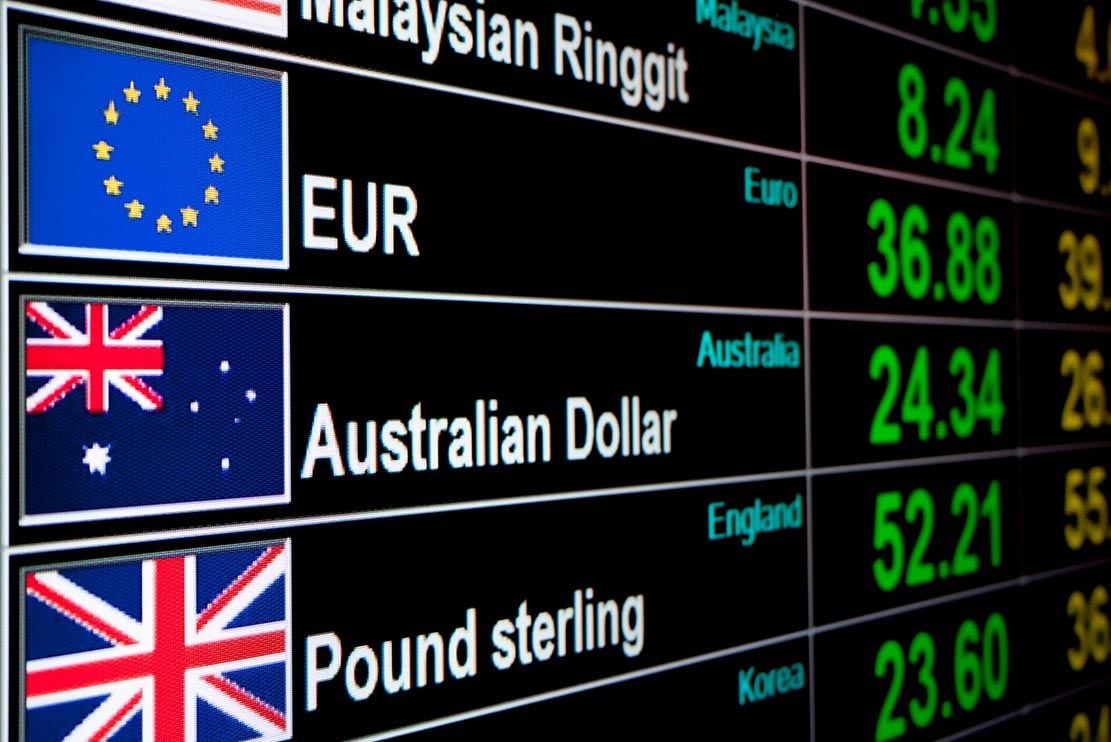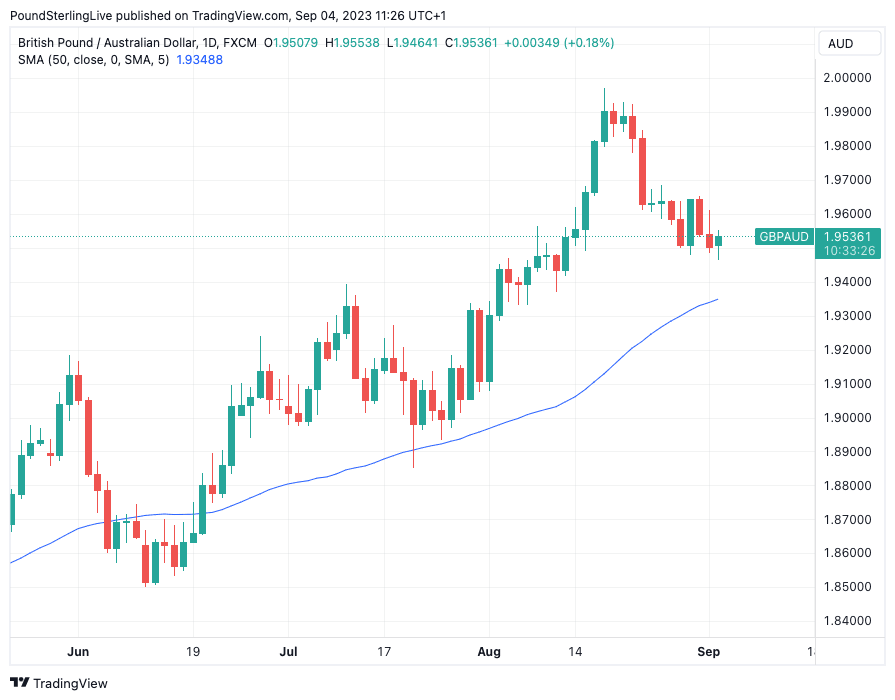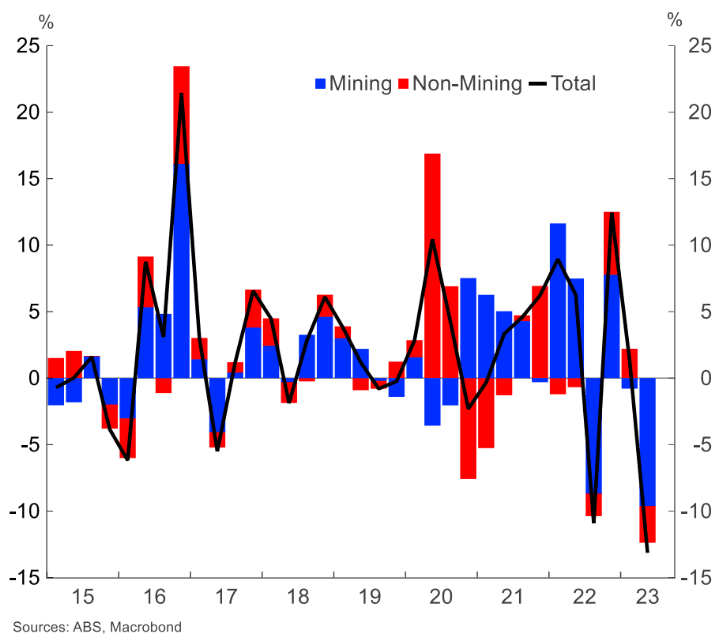GBP/AUD Rate Struggles to Reboot Rally, RBA and Chinese Stimulus in Focus
- Written by: Gary Howes
-
- GBPAUD extends recent pullback from highs
- As upside momentum wanes
- Amidst improved sentiment towards China
- RBA is key event to watch this week

Image © Adobe Stock
The Pound to Australian Dollar exchange rate looks to be a risk of extending a recent pullback over the coming days amidst a boost to the Aussie linked to Chinese stimulus and expectations for a 'hawkish' Reserve Bank of Australia (RBA) decision.
GBPAUD has retreated from a 2023 high of 1.9971, reached on August 17, to current levels at 1.9529.
A cursory glance at the daily chart suggests some degree of support is located around current levels, which could offer the pair a chance of stabilisation over the coming days and hours.
But, the broader trend still favours further GBPAUD upside given the pair remains above the important moving averages with key downside levels yet to be breached:
The above chart shows momentum is still positive with the exchange rate residing above the 50-day moving average. A break below this trend indicator would be an initial signal that a broader turnaround in fortunes for the dominant Pound Sterling is potentially underway.
For now, therefore, the recent pullback is viewed as a countertrend rebalancing that will likely restart at some point.
But there is little evidence that the pullback is about to fade and the coming days could yet see further weakness in GBPAUD, particularly given the recent improved sentiment towards China.
Indeed, a pullback towards the 50-day MA, shown in the above chart, could yet occur, suggesting levels closer to 1.94 could be tested.
Underscoring a recent recovery in the Aussie Dollar is a sense that 'peak pessimism' towards China might have been reached, which suggests recovery potential for Chinese assets, with which AUD is positively aligned.
Chinese stocks and commodities moved higher at the start of the new week as investors welcomed recent efforts by authorities to boost the economy, particularly regarding housing.
The CSI 300 index of Shanghai and Shenzhen-listed stocks advanced 1.5% and Hong Kong’s Hang Seng rose 2.5%, led by sharp gains for developer stocks after Beijing announced policies to allow a dozen of the country’s largest cities to reduce downpayments for homebuyers and encouraged lenders to cut interest rates on existing mortgages.
The Australian Dollar is particularly exposed to the housing and infrastructure elements of China's economy given they are a source of demand for Australia's raw material exports.
Therefore, hopes of improvement in this sector bode well for Australia's foreign exchange earnings, which are ultimately supportive of Aussie Dollar valuations.
It is reported the latest policies are designed to support China's once-dominant property sector, which has struggled in the face of weak demand after the country reopened after three years of severe pandemic restrictions.
Shares in Chinese property developer Country Garden rose 14.6% after the company gained approval from its creditors over the weekend to restructure the repayment of an almost Rmb4bn ($550mn) bond that had been set to mature on Saturday.
"Recent actions by Chinese policymakers have boosted our confidence for a restart in the recovery alongside some stabilization in property. We see these dynamics as supporting our positive fundamental view on AUDUSD over 6–12 months," says Teck Leng Tan, a Strategist at UBS in Singapore.
Above: Australian company profits are sharply down, led by mining, which has suffered amidst a commodity price downturn. Image: St. George Bank.
News out of China will remain a key consideration for the Australian Dollar over the coming weeks, but the immediate domestic focus is Tuesday's Reserve Bank of Australia policy decision.
The market expects the RBA to keep interest rates on hold, however, upside risks to the Australian Dollar would emerge if the central bank signalled it might be inclined to raise interest rates again in the future.
"We expect the Reserve Bank of Australia (RBA) to keep rates on hold at 4.10% on 5 September," says Edward Lee, Chief Economist for ASEAN and South Asia at Standard Chartered Bank in Singapore.
Recent data indicates inflation is slowing in line with RBA expectations with Q2 CPI inflation reading slightly lower than the central bank’s May forecast.
The labour market may have also peaked, says Lee, observing a slight rise in the unemployment rate and easing labour demand in Q2.
Spending has meanwhile continued to slow, with retail spending largely flat since Q3-2022, even though it has been running above pre-pandemic trend.
But, Standard Chartered still expects a 25bps hike in November as services CPI remains sticky (services CPI ex-volatile items rose 1.6% q/q SA in Q2 vs 1.3% in Q1).
"The job market may have peaked but remains tight and should support wage growth. This, along with the monthly rise in home prices, may prop up spending, especially if households dip into their significant excess savings. The lack of a productivity pick-up may also increase unit labour costs, adding to inflation," says Lee.
UBS thinks the RBA will keep the cash rate on hold at 4.1% but sees the risks as skewed toward another 25-basis-point hike, most likely in November.
Should such an eventuality to be confirmed by the RBA's guidance then the Aussie Dollar could find further bids, pressuring the GBPAUD exchange rate lower in the near-term.







